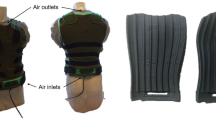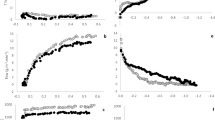Abstract
Objective
This study tested the hypothesis that intermittent cooling in air-perfused vests (APV) will not only maintain thermal balance but, due to cyclical activations of cutaneous thermoreceptors, also enhance thermal perceptions.
Method
Ten physically active males completed four conditions where they exercised (walking: 5 km h−1, 2 % gradient) in a hot environment (~34.0 °C, 50 % RH) for 72 min, followed by a 33-min period of rest. They wore an APV throughout. The four conditions differed in respect to the profile of ambient air that was perfused through the APV: continuous perfusion (CP); intermittent perfusion of 6 min ON/OFF periods (IPonoff); a steady increase and decrease in flow rate in equal increments (IPramp); and an initial step-increase in the flow rate followed by an incremental decrease to zero flow rate (IPtriang). Whole body and torso thermal comfort (TC, TTC), whole body and torso temperature sensation (TS, TTS), whole body and torso skin temperature (\(\bar{T}_{\text{sk}}\), \(\bar{T}_{\text{sktorso}}\)), local relative humidity (\(\overline{RH}_{\text{torso}}\)) and rectal temperature (T re) were measured.
Results
There were no significant differences in T re, absolute whole body and local \(\bar{T}_{\text{sk}}\), TC, TTC and TS between the cooling profiles. However, TTS was cooler in CP and IPramp than IPonoff and IPtriang. Even though intermittent cooling did not significantly enhance thermal perceptions in CP, a trend existed for TC (P = 0.063) to become less favourable over time.
Conclusion
To reduce the power consumption and extend the battery life of an APV, it is recommended that an intermittent cooling profile should be adopted.






Similar content being viewed by others
References
Ackerley R, Olausson H, Wessberg J, McGlone F (2012) Wetness perception across body sites. Neurosci Lett 522:73–77
Arens E, Xu T, Miura K, Hui Z, Fountain M, Bauman F (1998) A study of occupant cooling by personally controlled air movement. Energy Build 27:45–49
Arens E, Zhang H, Huizenga C (2006) Partial- and whole body thermal sensation and comfort—part II: non-uniform environmental conditions. J Therm Biol 31:60–66
Barwood M, Newton P, Tipton M (2009) Ventilated vest and tolerance for intermittent exercise in hot, dry conditions with military clothing. Aviat Space Environ Med 80:353–359
Bomalaski S, Chen Y, Constable S (1995) Continuous and intermittent personal microclimate cooling strategies. Aviat Space Environ Med 66:745–750
Borg G (1971) The perception of physical performance. In: Shephard R, Thomas C (eds) Frontiers of fitness. Charles C. Thomas, Springfield, pp 280–294
Cabanac M, Cunningham D, Stolwijk J (1971) Thermoregulatory set point during exercise: a behavioural approach. J Comp Physiol Psychol 76(1):94–102
Cadarette BS, Cheuvront SN, Kolka MA, Stephenson LA, Montain SJ, Sawka MN (2006) Intermittent microclimate cooling during exercise-heat stress in US army chemical protective clothing. Ergonomics 49(2):209–219
Cheung SS, McLellan TM, Tenaglia S (2000) The thermophysiology of uncompensable heat stress. Sports Med 29(5):329–359
Davey S, Reilly T, Newton M, Tipton M (2007) The reproducibility and validity of visual analogue scales (VAS) that assess thermal perceptions in stable and dynamic, asymmetric environments. In: Proceedings of the 12th International Conference of Environmental Ergonomics, 19–24 August 2007, Piran, Slovenia
Davey S, Barwood M, Tipton M (2009) The influence of the rate of torso skin temperature change on thermal perceptions whilst exercising in the heat. In: Proceedings of the 13th International Conference of Environmental Ergonomics, 2–7 August 2009, Boston, USA
de Dear R (2011) Revisiting an old hypothesis of human thermal perception: alliesthesia. Build Res Inf 39(2):108–117
de Dear R, Brager G (2001) The adaptation model of thermal comfort and energy conservation in built environment. In J Biometerol 45(2):100–108
de Dear R, Ring J, Fanger P (1993) Thermal sensation resulting from sudden ambient temperature changes. Indoor Air 3:181–192
Dorman L, Havenith G (2009) The effects of protective clothing on energy consumption during different activities. Eur J Appl Physiol 105(3):463–470
Fanger P, Melikov H, Hanzawa H, Ring J (1988) Air turbulence and the sensation of draught. Energy Build 12(1):21–39
Flouris A, Cheung S (2009) Human consciousness response to thermal input is adjusted to changes in mean body temperature. Br J Sports Med 43:199–203
Frank SM, Srinivasa N, Raja N, Bulcao CF, Goldstein DS (1999) Relative contribution of core and cutaneous temperatures to thermal comfort and autonomic responses in humans. J Appl Physiol 86(5):1588–1593
Gagge A, Fobelets A, Berglund L (1986) A standard predictive index of human response to the thermal environment. ASHRAE Trans 92(2B):709–731
Gagge AP, Stolwijk JAJ, Hardy JD (1967) Comfort and thermal sensation and associated physiological responses at various ambient temperatures. Environ Res 1:1–20
Hancock P, Ross J, Szalma J (2007) A meta-analysis of performance response under thermal stressors. Hum Factors 49(5):851–877
Hardy J, Dubois E (1938) The technic of measuring radiation and convection. J Nutrition 15:461–475
Hensel H (1981) Thermoreception and temperature regulation. Academic Press, London
Hexamer M, Werner J (1997) Control of liquid cooling garments, technical control of mean skin temperature and it’s adjustment to exercise. Appl Hum Sci 16:237–247
ISO 7933 (2002) Ergonomics of the thermal environment—analytical determination and interpretation of heat stress using calculation of the predicted heat strain. International Organisation of Standardisation, Geneva
Keatinge W, Mason A, Millard C, Newstead C (1986) Effects of fluctuating skin temperature on thermoregulatory responses in man. J Physiol 378:241–252
Lv Yong-Gang, Liu J (2007) Effect of transient temperature on thermoreceptor response and thermal sensation. Build Environ 42:656–664
Mayer E (1987) Measurement of the convective surface coefficient of heat transfer of man. Room Vent 87, Session 2b June 10, Stockholm, Sweden
McLellan TM, Frim J, Bell DG (1999) Efficacy of air and liquid cooling during light and heavy exercise while wearing NBC clothing. Aviat Space Environ Med 70:802–811
Newton M, Barwood M, Tipton M (2009) The sensitivity of initial thermal perceptions when altering local skin temperatures by modifying microclimate relative humidity. In: Proceedings of the 13th International Conference of Environmental Ergonomics, 2–7 August 2009, Boston, USA
Nybo L, Nielsen B (2001) Hyperthermia and central fatigue during prolonged exercise in humans. J Appl Physiol 91:1055–1060
Ring JW, De Dear R, Melikov A (1993) Human thermal sensation, frequency response to sinusoidal stimuli at the surface of the skin. Energy Build 20:159–165
Robertson R (1982) Central signals of perceived exertion during dynamic exercise. Med Sci Sports Exerc 14(5):390–396
Sawka M, Young A, Latzka W, Neufer P, Quigley M, Pandolf K (1992) Human tolerance to heat strain during exercise; influence of hydration. J Appl Physiol 73:368–375
Shapiro Y, Pandolf M, Sawka N, Toner M, Winsmann F, Goldman R (1982) Auxillary cooling: comparison of air-cooled vs. water-cooled vests in hot-dry and hot-wet environments. Aviat Space Environ Med 53(8):785–789
Siri WE (1961) Body composition from fluid space and density. In: Brozek J, Hanschel A (eds) Techniques for measuring body composition. National Academy of Science, Washington, DC, pp 223–244
Speckman KL, Allen AE, Sawka MN, Young AJ, Muza SR, Pandolf KB (1988) Perspectives in microclimate cooling involving protective clothing in hot environments. Int J Ind Ergon 3:121–147
Stephenson LA, Vernieuw CR, Leammukda W, Kolka MA (2007) Skin microclimate feedback optimizes microclimate cooling. Aviat Space Environ Med 78:377–382
Tanabe S, Kimura K (1994) Effects of air temperature, humidity, and air movement on thermal comfort under hot and humid conditions. ASHRAE Trans 100:953–969
Thompson W, Gordon N, Pescatello L (2010) ACSM’s guidelines for exercise testing and prescription, 8th edn. American College of Sports Medicine, Baltimore, p 84
Toftum J, Jorgensen A, Fanger PO (1998) Upper limits for indoor relative humidity to avoid uncomfortably humid skin. Energy Build 28:1–13
Vernieuw CR, Stephenson L, Kolka M (2007) Thermal comfort and sensation in men wearing a cooling system controlled by skin temperature. Hum Factors 49(6):1033–1044
Walters T, Ryan K, Tate L, Mason P (2000) Exercise in the heat is limited by a critical internal temperature. J Appl Physiol 89:799–806
Withers T, Craig N, Bourdon P, Norton K (1987) Relative body fat and anthropometric prediction of body density of male athletes. Eur J Appl Physiol Occup Physiol 56(2):191–200
Zhang H (2003) Human thermal sensation and comfort in transient and non-uniform thermal environments. PhD thesis, University of California, Berkley, CA, 94720-1839, USA
Zhou X, Ouyang Q, Lin Y, Zhu Y (2006) Impact of dynamic airflow on human thermal response. Indoor Air 16:348–355
Acknowledgments
This research is financially supported by University of Portsmouth and W.L. Gore & Associates. The authors would like to thank Geoff Long, Mark Newton, and Nicola Ferguson for all their technical support on this project and the participants for their efforts.
Conflict of interest
The authors declare that they have no conflict of interest.
Ethical consideration
This experiment was approved by the University of Portsmouth Biosciences Research Ethics Committee. It complies with all current legislation, including the Declaration of Helsinki, as adopted at the 52nd WMA General Assembly, Edinburgh, October 2000.
Author information
Authors and Affiliations
Corresponding author
Additional information
Communicated by Narihiko Kondo.
Rights and permissions
About this article
Cite this article
Davey, S.L., Barwood, M.J. & Tipton, M.J. Thermal perceptions and skin temperatures during continuous and intermittent ventilation of the torso throughout and after exercise in the heat. Eur J Appl Physiol 113, 2723–2735 (2013). https://doi.org/10.1007/s00421-013-2697-5
Received:
Accepted:
Published:
Issue Date:
DOI: https://doi.org/10.1007/s00421-013-2697-5




